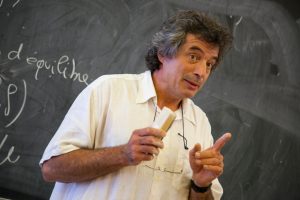
This post is about the deformation of a Markov diffusion by a diffeomorphism, in other words, the change of variable, and its usage to flatten the diffusion coefficient.
A Markov diffusion and a diffeomorphism. The class of Markov diffusion processes is globally stable under diffeomorphisms. Indeed, let ${(X_t)}_{t\geq0}$ be a Markov diffusion process on $\mathbb{R}^d$, solving the stochastic differential equation \[ \mathrm{d}X_t=\sigma(X_t)\mathrm{d}B_t+b(X_t)\mathrm{d}t \] where ${(B_t)}_{t\geq0}$ is a standard Brownian motion on $\mathbb{R}^n$, $\sigma$ is a $\mathcal{C}^2$ matrix field of dimension $d\times n$, and $b$ is a $\mathcal{C}^2$ vector field of dimension $d$. We say that $\sigma$ is the diffusion matrix and that $b$ is the drift of the stochastic process $X$. Now we pick a diffeomorphism $\varphi:\mathbb{R}^d\to\mathbb{R}^d$. By Itô's formula, the deformed diffusion process \[ {(Y_t)}_{t\geq0}={(\varphi(X_t))}_{t\geq0} \] solves the stochastic differential equation \[ \mathrm{d}Y_t=\widetilde\sigma(Y_t)\mathrm{d}B_t+\widetilde b(Y_t)\mathrm{d}t \] where \[ \widetilde\sigma(y)=\varphi'(x)\sigma(x) \quad\text{and}\quad \widetilde b(y)=\varphi'(x)b(x)+\tfrac{1}{2}\sigma^2(x)\varphi''(x) \] when $n=d=1$, with $x=\varphi^{-1}(y)$, and more generally \[ \widetilde\sigma(y)=\varphi'(x)\sigma(x) \quad\text{and}\quad \widetilde b(y)=\varphi'(x)b(x)+[\tfrac{1}{2}\sigma(x)\sigma^\top(x):\varphi''(x)] \] where \[ [A(x):\varphi''(x)]_i=\sum_{jk}A_{jk}(x)((\varphi_i)'')_{jk}(x). \] We use here the lightweight notation $F'=DF$ and $F''=D^2F$, also $(\varphi_i)''=\mathrm{Hess}(\varphi_i)$. Since $\varphi''(x)$ is $3$-tensor, what we do here is the contraction of two indices. This term involving $\varphi''(x)$ is the contribution of the non-affine part of $\varphi$, the effect of $\sigma$ on $\widetilde b$.
In the isotropic case $d=n$ and $\sigma(x)=\sigma(x)\mathrm{Id}$, $\sigma(x) > 0$, we find \[ [\tfrac{1}{2}\sigma(x)\sigma(x)^\top:\varphi''(x)]_i =\tfrac{1}{2}\sigma^2(x)\mathrm{Tr}((\varphi_i)''(x)) =\tfrac{1}{2}\sigma^2(x)\Delta(\varphi_i)(x). \] The coefficients $\widetilde\sigma$ and $\widetilde b$ depend on the diffeomorphism $\varphi$ only via its first and second derivatives, but the initial condition of the stochastic differential equation is $Y_0=\varphi(X_0)$.
We recover $Y=X$ when $\varphi(x)=x$ for all $x$. Indeed, we have then $\varphi'(x)=\mathrm{Id}$ for all $x$, thus $\varphi''\equiv0$, giving $\widetilde\sigma=\sigma$ and $\widetilde b=b$. More generally, if $\varphi$ is affine, say $\varphi(x)=Bx+C$ for fixed matrices $B$ and $C$, then $\varphi'\equiv B$ and $\varphi''\equiv0$, giving $\widetilde\sigma=B\sigma$ and $\widetilde b=Bb$.
Semigroup and conjugacy. The Markov semigroup ${(Q_t)}_{t\geq0}$ of $Y$ is related to the Markov semigroup ${(P_t)}_{t\geq0}$ of $X$. Indeed, for every bounded measurable $f:\mathbb{R}^d\to\mathbb{R}$, \begin{align*} Q_t(f)(y) &=\mathbb{E}(f(Y_t)\mid Y_0=y)\\ &=\mathbb{E}(f(\varphi(X_t))\mid\varphi(X_0)=y)\\ &=\mathbb{E}((f\circ\varphi)(X_t)\mid X_0=\varphi^{-1}(y))\\ &=P_t(f\circ\varphi)(\varphi^{-1}(y)) \end{align*} In other words $Q_t$ is obtained from $P_t$ by conjugacy in the sense that \[ Q_t=\Phi^{-1}\circ P_t\circ\Phi \] where $\Phi$ is the linear map $f\mapsto f\circ\varphi$, with inverse $f\mapsto f\circ\varphi^{-1}$. The conjugacy writes also \[ \Phi\circ Q_t=P_t\circ\Phi. \] This formulation has the advantage of avoiding the inversion of $\Phi$. It may still hold true for degenerate situations where $\Phi$ is no longer invertible. It reminds the fruitful notion of intertwining or interlacement of Markov semigroups, in which $\Phi$ is a Markov kernel.
Invariant measure. The conjugacy of semigroups implies that if $X$ admits an invariant measure $\mu$ then the measure $\mu\circ\varphi^{-1}$ is invariant for $Y$. A famous case for which $X$ admits an invariant measure is given by $d=n$, a constant diffusion matrix $\sigma=\sigma\mathrm{Id}$, $\sigma > 0$, and a drift $b(x)=-\nabla V(x)$, $V:\mathbb{R}^d\to\mathbb{R}$. Then $\mu=\mathrm{exp}(-\frac{2}{\sigma^2}V(x))\mathrm{d}x$ is invariant.
Generator and flattening. The conjugacy of semigroups gives also that the infinitesimal generator $G$ of ${(P_t)}_{t\geq0}$ and $H$ of ${(Q_t)}_{t\geq0}$ are related by conjugacy, in the sense that \[ H=\Phi^{-1}\circ G\circ\Phi \] namely $H(f)(y)= G(f\circ\varphi)(\varphi^{-1}(y))$. In particular, when $d=n=1$, we find \begin{align*} G(g)(x)&=\tfrac{1}{2}\sigma^2(x)g''(x)+b(x)g'(x)\\ H(f)(y)&=\tfrac{1}{2}\varphi'^2(x)\sigma^2(x)f''(y) +\bigr(\varphi'(x)b(x)+\tfrac{1}{2}\sigma^2(x)\varphi''(x)\bigr)f'(y),\quad x=\varphi^{-1}(y). \end{align*} In particular, in the special case where $\varphi'(x)=1/\sigma(x)$ we find \[ Hf=\frac{1}{2}f'' +\Bigr(\frac{b\circ\varphi^{-1}}{\sigma\circ\varphi^{-1}}-\frac{1}{2}\sigma'\circ\varphi^{-1}\Bigr)f'. \] To summarize, taking $\varphi'=1/\sigma$ has the effect of flattening the diffusion coefficient, making $Y$ a Euclidean diffusion, in the sense that the diffusion coefficient of $Y$ is constant, in other words $Y$ is a Brownian motion with drift, which is easier to study.
In higher dimension, \[ G=\frac{1}{2}\sum_{i,j=1}^dA_{ij}\partial_{ij}^2+\sum_{i=1}^db_i\partial_i \quad\text{where}\quad A=\sigma\sigma^\top, \] but the flattening is not always obvious or possible. Let us consider the special case where $d=n$ and where $\sigma(x)=\mathrm{diag}(\sigma_1(x_1),\ldots,\sigma_d(x_d))$. Then the tensor product map $\varphi(x)=(\varphi_1(x_1),\ldots,\varphi_d(x_d))$ with $\varphi_i'=1/\sigma_i$ is a flattening diffeomorphism, giving \begin{align*} H=\frac{1}{2}\Delta +\sum_{i=1}^d\Bigr(\frac{b_i\circ\varphi^{-1}}{\sigma_i\circ\varphi_i^{-1}}-\frac{1}{2}\sigma'_i\circ\varphi_i^{-1}\Bigr)\partial_i. \end{align*}
Isometry and spectrum. Suppose that $X$ has invariant measure $\mu$. It is then customary to see $G$ as an unbounded operator defined on the Hilbert space $L^2(\mu)$. In this case, the linear map $\Phi$ is an isometry from $L^2(\nu)$ to $L^2(\mu)$ where $\nu=\mu\circ\varphi^{-1}$ is the invariant measure of $Y$. Indeed, for all $f\in L^2(\nu)$, \[ \int\Phi(f)^2\mathrm{d}\mu =\int (f\circ\varphi)^2\mathrm{d}\mu =\int f^2\mathrm{d}\nu. \] Thus $G$ and $H$ have same spectral resolution. In particular, they have same eigenvalues and spectral gap, and the eigenfunctions of $H$ are the ones of $G$ composed with $\varphi^{-1}$.
Curvature-dimension. Thanks to the conjugacy, the processes $X$ and $Y$ satisfy the same curvature-dimension inequalities. The carré du champ $\Gamma$ and the $\Gamma_2$ operators of $X$ and $Y$ are related by the change of variable formulas for $\Gamma$ and $\Gamma_2$. Geometrically, the time behavior of the deformation $Y$ is identical to the one of $X$ provided that we measure distances using the deformed metric, since the deformation is invertible or elastic. In the same spirit, it is always possible to interpret the diffusion coefficient as a metric and the diffusion as a drifted Brownian motion on $\mathbb{R}^d$ seen as a (curved) Riemannian manifold. From this point of view, the diffeomorphism, when possible, can be used to flatten the space : by taking $\varphi'=1/\sigma$, the diffusion with variable coefficient $X$ can be studied as a deformation by $\varphi^{-1}$ of the diffusion $Y$ with constant coefficient, they have the same time behavior and trend toward equilibrium. The intrinsic Riemannian distance is then naturally used to define intrinsic Wasserstein distances, intrinsic regularization, intrinsic functional inequalities, etc.
Basic one-dimensional examples on restricted space.
- Laguerre : from $\mathbb{R}_+$ to $\mathbb{R}_+$. \begin{align*} \mu&=\mathrm{Gamma}(a,1)\propto x^{a-1}\mathrm{e}^{-x}\mathrm{d}x\\ G(f)(x)&=xf''(x)+(a-x)f'(x)\\ \varphi(x)&=\sqrt{2x}\\ H(g)(y)&=\frac{1}{2}g''(y)+\Bigr(\frac{a-\frac{1}{2}}{y}-\frac{y}{2}\Bigr)g'(y) \end{align*}
- Wright-Fisher or Jacobi : from $[0,1]$ to $[0,\frac{\pi}{2}]$. \begin{align*} \mu&=\mathrm{Beta}(a,b)\propto x^{a-1}(1-x)^{b-1}\mathrm{d}x\\ G(f)(x)&=\frac{x(1-x)}{2}f''(x)+\frac{a(1-x)+bx}{2}f'(x)\\ \varphi(x)&=\sqrt{2\arcsin(x)}\\ H(g)(y)&=\frac{1}{2}g''(y) +\frac{a-b+(a+b-\frac{1}{2})\cos(y)}{\sin(y)}g'(y) \end{align*}
Further reading.
- Philippe Biane
Intertwining of Markov semi-groups, some examples
Séminaire de probabilités 29 30-36 (1995) - Dominique Bakry, Ivan Gentil, and Michel Ledoux
Analysis and Geometry of Markov Diffusion Operators
Springer (2014) - Samuel Chan-Ashing
On The Cutoff Phenomenon For Dyson-Laguerre Processes
Preprint arXiv:2509.19798